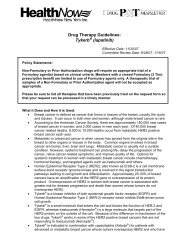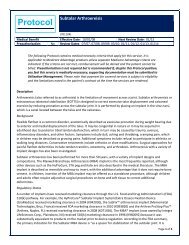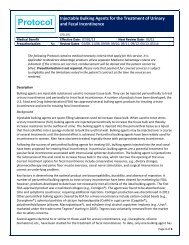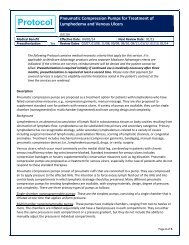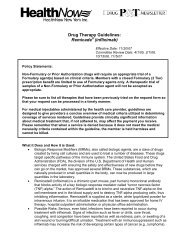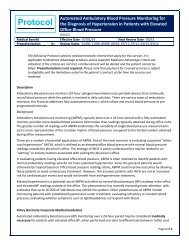Biofeedback as a Treatment of Fecal Incontinence or Constipation
Biofeedback as a Treatment of Fecal Incontinence or Constipation
Biofeedback as a Treatment of Fecal Incontinence or Constipation
Create successful ePaper yourself
Turn your PDF publications into a flip-book with our unique Google optimized e-Paper software.
Protocol<br />
<strong>Bi<strong>of</strong>eedback</strong> <strong>as</strong> a <strong>Treatment</strong> <strong>of</strong> <strong>Fecal</strong> <strong>Incontinence</strong> <strong>or</strong><br />
<strong>Constipation</strong><br />
(20164)<br />
Medical Benefit Effective Date: 07/01/13 Next Review Date: 03/15<br />
Preauth<strong>or</strong>ization No Review Dates: 09/07, 09/08, 09/09, 09/10, 09/11, 07/12, 03/13, 03/14<br />
The following Protocol contains medical necessity criteria that apply f<strong>or</strong> this service. It is<br />
applicable to Medicare Advantage products unless separate Medicare Advantage criteria are<br />
indicated. If the criteria are not met, reimbursement will be denied and the patient cannot be<br />
billed. Preauth<strong>or</strong>ization is not required but is recommended if, despite this Protocol position,<br />
you feel this service is medically necessary. Ple<strong>as</strong>e note that payment f<strong>or</strong> covered services is<br />
subject to eligibility and the limitations noted in the patient’s contract at the time the services<br />
are rendered.<br />
Description<br />
<strong>Bi<strong>of</strong>eedback</strong> is a technique to teach patients self-regulation <strong>of</strong> physiological processes not generally considered<br />
to be under voluntary control; a variety <strong>of</strong> approaches and devices are available. Among other possible<br />
indications, bi<strong>of</strong>eedback is proposed <strong>as</strong> a treatment <strong>of</strong> fecal incontinence and constipation.<br />
Background<br />
<strong>Bi<strong>of</strong>eedback</strong>, a technique intended to teach patients self-regulation <strong>of</strong> certain physiologic processes not<br />
n<strong>or</strong>mally considered to be under voluntary control, is used to treat a variety <strong>of</strong> conditions and is proposed <strong>as</strong> a<br />
treatment <strong>of</strong> fecal incontinence and constipation.<br />
<strong>Fecal</strong> incontinence in adults is the recurrent uncontrolled p<strong>as</strong>sage <strong>of</strong> fecal material. Pathophysiology <strong>of</strong> the<br />
dis<strong>or</strong>der ranges from abn<strong>or</strong>malities in intestinal motility (diarrhea <strong>or</strong> constipation) to po<strong>or</strong> rectal compliance,<br />
impaired rectal sensation, <strong>or</strong> weak <strong>or</strong> damaged pelvic flo<strong>or</strong> muscles. There is no incre<strong>as</strong>e in m<strong>or</strong>tality<br />
attributable to fecal incontinence. M<strong>or</strong>bidity includes skin breakdown and urinary tract infections. <strong>Fecal</strong><br />
incontinence may affect quality <strong>of</strong> life through restricting w<strong>or</strong>k, recreation, and activities related to “getting out<br />
<strong>of</strong> the house,” impaired social role function, diminished sexual activity, and incre<strong>as</strong>e <strong>of</strong> social isolation due to<br />
embarr<strong>as</strong>sment. <strong>Fecal</strong> incontinence can bring about loss <strong>of</strong> independence and mobility. It is the second most<br />
common re<strong>as</strong>on f<strong>or</strong> elderly institutionalization. The most common causes <strong>of</strong> fecal incontinence in adults are<br />
obstetric trauma coupled with age-related degeneration, previous an<strong>or</strong>ectal surgery, rectal prolapse, and<br />
perineal trauma. In many individuals, the condition is multifact<strong>or</strong>ial, involving a combination <strong>of</strong> structural,<br />
physiological, and psychosocial fact<strong>or</strong>s. Conventional interventions to treat fecal incontinence include dietary<br />
recommendations (e.g., fiber), bowel and toilet scheduling, and medications (e.g., bulking <strong>or</strong> antidiarrheal<br />
agents).<br />
<strong>Constipation</strong> refers to infrequent bowel movements and difficulty expelling stool during defecation. Primary<br />
constipation is generally categ<strong>or</strong>ized into three groups. The most common type is n<strong>or</strong>mal-transit constipation in<br />
which there is a n<strong>or</strong>mal rate <strong>of</strong> stool movement, but patients feel constipated and may complain <strong>of</strong> abdominal<br />
pain and/<strong>or</strong> bloating. In the second type, slow-transit constipation, stool moves m<strong>or</strong>e slowly through the colon<br />
and individuals <strong>of</strong>ten experience a limited urge to defecate. The third type, dyssynergic defecation, refers to a<br />
loss <strong>of</strong> ability to co<strong>or</strong>dinate contractions <strong>of</strong> the pelvic flo<strong>or</strong> muscles and to relax the anal sphincter during<br />
defecation. Patients <strong>of</strong>ten rep<strong>or</strong>t an inability to defecate despite the urge to do so. There are also secondary<br />
causes <strong>of</strong> constipation such <strong>as</strong> the use <strong>of</strong> certain medications, including opioids and psychoactive drugs;<br />
neurologic, endocrine, <strong>or</strong> metabolic dis<strong>or</strong>ders; structural abn<strong>or</strong>malities; and lifestyle fact<strong>or</strong>s. Conventional<br />
Page 1 <strong>of</strong> 5
Protocol <strong>Bi<strong>of</strong>eedback</strong> <strong>as</strong> a <strong>Treatment</strong> <strong>of</strong> <strong>Fecal</strong> <strong>Incontinence</strong> <strong>or</strong> <strong>Constipation</strong> L<strong>as</strong>t Review Date: 03/14<br />
treatment includes dietary changes (i.e., adequate fiber and fluid intake), use <strong>of</strong> supplemental bulking<br />
substances, exercises, and medications.<br />
In children, most c<strong>as</strong>es <strong>of</strong> fecal incontinence and constipation are functional, in which structural, endocrine, <strong>or</strong><br />
metabolic dise<strong>as</strong>es have been ruled out. Fact<strong>or</strong>s contributing to functional incontinence and constipation are<br />
fear and/<strong>or</strong> pain <strong>as</strong>sociated with large, hard stools. This leads to retentive posturing in approximately half the<br />
children with chronic constipation (i.e., the avoidance <strong>of</strong> defecation by purposefully contracting the external<br />
anal sphincter, also termed anismus <strong>or</strong> paradoxical sphincter contraction). Customary <strong>or</strong> conventional medical<br />
intervention includes dietary changes, bowel and toilet scheduling, s<strong>of</strong>tening agents, and education. Behavi<strong>or</strong>al<br />
interventions aim at rest<strong>or</strong>ing n<strong>or</strong>mal bowel habits through toilet training, reward and incentive contingency<br />
management programs, desensitization <strong>of</strong> phobia and fear, <strong>or</strong> skill-building and goal-setting techniques with<br />
home practice. Counseling and psychotherapy provide supp<strong>or</strong>t to the child and address social and psychological<br />
problems.<br />
<strong>Bi<strong>of</strong>eedback</strong> training f<strong>or</strong> fecal incontinence focuses on improving the ability to voluntarily contract the external<br />
anal sphincter and pub<strong>or</strong>ectalis muscles in response to rectal filling and to decre<strong>as</strong>e delay in response to a<br />
sensation <strong>of</strong> distension. F<strong>or</strong> constipation, the aim <strong>of</strong> bi<strong>of</strong>eedback is to teach patients how to tighten and relax<br />
their external anal sphincter in <strong>or</strong>der to p<strong>as</strong>s bowel movements.<br />
<strong>Bi<strong>of</strong>eedback</strong> attempts to improve rectal sens<strong>or</strong>y perception, strength, co<strong>or</strong>dination, <strong>or</strong> some combination <strong>of</strong><br />
these three components. Sens<strong>or</strong>y training involves inducing intrarectal pressure using a balloon feedback<br />
device. A manometric balloon probe is inserted into the rectum, and the balloon is filled with air to produce a<br />
sensation <strong>of</strong> rectal filling. Strength training uses either anal canal pressure (manometric) <strong>or</strong> intra-anal<br />
electromyography (EMG) feedback <strong>of</strong> pelvic flo<strong>or</strong> muscles (PFM). The purpose is to strengthen the f<strong>or</strong>ce <strong>of</strong> the<br />
PFM contraction without including rectal distention. Some training incre<strong>as</strong>es endurance (duration <strong>of</strong> external<br />
anal sphincter contraction), <strong>as</strong> well <strong>as</strong> peak strength. Co<strong>or</strong>dination training uses pressure feedback <strong>of</strong> intrarectal<br />
balloon distention using a water-perfused catheter <strong>or</strong> Schuster-type balloon probe and PFM contractions<br />
in a simultaneous feedback display. The purpose <strong>of</strong> co<strong>or</strong>dination training is to synchronize the contraction <strong>of</strong> the<br />
external anal sphincter with relaxation <strong>of</strong> the internal anal sphincter.<br />
<strong>Bi<strong>of</strong>eedback</strong> techniques convert the physiologic me<strong>as</strong>ures from an intra-anal EMG sens<strong>or</strong>, anal manometric<br />
probe (me<strong>as</strong>uring intra-anal pressure), <strong>or</strong> perianal surface EMG electrodes to either visual <strong>or</strong> audio display f<strong>or</strong><br />
feedback. Ultr<strong>as</strong>ound h<strong>as</strong> also been used to show patients’ contraction <strong>of</strong> the anal sphincter on a screen.<br />
<strong>Bi<strong>of</strong>eedback</strong> training is done alone, <strong>or</strong> in combination with other behavi<strong>or</strong>al therapies designed to teach<br />
relaxation. Training sessions are perf<strong>or</strong>med in a quiet, non-arousing environment.<br />
Regulat<strong>or</strong>y Status<br />
A variety <strong>of</strong> bi<strong>of</strong>eedback devices are cleared f<strong>or</strong> marketing though the U.S. Food and Drug Administration’s<br />
(FDA) 510(k) marketing clearance process. These devices are designated by the FDA <strong>as</strong> cl<strong>as</strong>s II with special<br />
controls and are exempt from the premarket notification requirements. The FDA defines a bi<strong>of</strong>eedback device <strong>as</strong><br />
“an instrument that provides a visual <strong>or</strong> audit<strong>or</strong>y signal c<strong>or</strong>responding to the status <strong>of</strong> one <strong>or</strong> m<strong>or</strong>e <strong>of</strong> a patient’s<br />
physiological parameters (e.g., brain alpha wave activity, muscle activity, skin temperature, etc.) so that the<br />
patient can control voluntarily these physiological parameters.”<br />
Related Protocols<br />
<strong>Bi<strong>of</strong>eedback</strong> <strong>as</strong> a <strong>Treatment</strong> <strong>of</strong> Urinary <strong>Incontinence</strong> in Adults<br />
Transanal Radi<strong>of</strong>requency <strong>Treatment</strong> <strong>of</strong> <strong>Fecal</strong> <strong>Incontinence</strong><br />
Sacral Nerve Neuromodulation/Stimulation<br />
Page 2 <strong>of</strong> 5
Protocol <strong>Bi<strong>of</strong>eedback</strong> <strong>as</strong> a <strong>Treatment</strong> <strong>of</strong> <strong>Fecal</strong> <strong>Incontinence</strong> <strong>or</strong> <strong>Constipation</strong> L<strong>as</strong>t Review Date: 03/14<br />
Policy (F<strong>or</strong>merly C<strong>or</strong>p<strong>or</strong>ate Medical Guideline)<br />
<strong>Bi<strong>of</strong>eedback</strong> f<strong>or</strong> constipation in adults may be considered medically necessary f<strong>or</strong> patients with dyssynergiatype<br />
constipation <strong>as</strong> demonstrated by meeting all three <strong>of</strong> the following criteria:<br />
1. Symptoms <strong>of</strong> functional constipation that meet ROME III criteria (see Policy Guidelines).<br />
2. Objective physiologic evidence <strong>of</strong> pelvic flo<strong>or</strong> dyssynergia (see Policy Guidelines) demonstrated by<br />
inappropriate contraction <strong>of</strong> the pelvic flo<strong>or</strong> muscles <strong>or</strong> less than 20% relaxation <strong>of</strong> b<strong>as</strong>al resting sphincter<br />
pressure by manometry, imaging <strong>or</strong> EMG;<br />
3. Failed a three-month trial <strong>of</strong> standard treatments f<strong>or</strong> constipation including laxatives, dietary changes, and<br />
exercises (<strong>as</strong> many <strong>of</strong> the previous <strong>as</strong> are tolerated).<br />
<strong>Bi<strong>of</strong>eedback</strong> is considered investigational <strong>as</strong> a treatment <strong>of</strong> constipation in adults and children in all other<br />
situations.<br />
<strong>Bi<strong>of</strong>eedback</strong> is considered investigational <strong>as</strong> a treatment <strong>of</strong> fecal incontinence in adults and children.<br />
Policy Guideline<br />
Rome III Diagnostic Criteria f<strong>or</strong> Functional G<strong>as</strong>trointestinal Dis<strong>or</strong>ders, available on line at:<br />
(http://www.romecriteria.<strong>or</strong>g/<strong>as</strong>sets/pdf/19_RomeIII_apA_885-898.pdf):<br />
Rome III diagnostic criteria f<strong>or</strong> functional constipation*<br />
1. Must include two <strong>or</strong> m<strong>or</strong>e <strong>of</strong> the following:<br />
a. Straining during at le<strong>as</strong>t 25% <strong>of</strong> defecations<br />
b. Lumpy <strong>or</strong> hard stools in at le<strong>as</strong>t 25% <strong>of</strong> defecations<br />
c. Sensation <strong>of</strong> incomplete evacuation f<strong>or</strong> at le<strong>as</strong>t 25% <strong>of</strong> defecations<br />
d. Sensation <strong>of</strong> an<strong>or</strong>ectal obstruction/blockage f<strong>or</strong> at le<strong>as</strong>t 25% <strong>of</strong> defecations<br />
e. Manual maneuvers to facilitate at le<strong>as</strong>t 25% <strong>of</strong> defecations (e.g., digital evacuation, supp<strong>or</strong>t <strong>of</strong> the pelvic<br />
flo<strong>or</strong>)<br />
f. Fewer than three defecations per week<br />
2. Loose stools are rarely present without the use <strong>of</strong> laxatives<br />
3. Insufficient criteria f<strong>or</strong> irritable bowel syndrome<br />
*Criteria fulfilled f<strong>or</strong> the l<strong>as</strong>t three months with symptom onset at le<strong>as</strong>t six months pri<strong>or</strong> to diagnosis<br />
Rome III diagnostic criterion f<strong>or</strong> dyssynergic defecation:<br />
Inappropriate contraction <strong>of</strong> the pelvic flo<strong>or</strong> <strong>or</strong> less than 20% relaxation <strong>of</strong> b<strong>as</strong>al resting sphincter pressure with<br />
adequate propulsive f<strong>or</strong>ces during attempted defecation<br />
Guidance on bi<strong>of</strong>eedback protocol:<br />
The recommended treatment course f<strong>or</strong> patients with constipation who meet criteria is up to six bi<strong>of</strong>eedback<br />
sessions over three months. This is consistent with the protocol used in key randomized trials showing benefit <strong>of</strong><br />
bi<strong>of</strong>eedback f<strong>or</strong> selected patients.<br />
Services that are the subject <strong>of</strong> a clinical trial do not meet our Technology Assessment Protocol criteria and are<br />
Page 3 <strong>of</strong> 5
Protocol <strong>Bi<strong>of</strong>eedback</strong> <strong>as</strong> a <strong>Treatment</strong> <strong>of</strong> <strong>Fecal</strong> <strong>Incontinence</strong> <strong>or</strong> <strong>Constipation</strong> L<strong>as</strong>t Review Date: 03/14<br />
considered investigational. F<strong>or</strong> explanation <strong>of</strong> experimental and investigational, ple<strong>as</strong>e refer to the Technology<br />
Assessment Protocol.<br />
It is expected that only appropriate and medically necessary services will be rendered. We reserve the right to<br />
conduct prepayment and postpayment reviews to <strong>as</strong>sess the medical appropriateness <strong>of</strong> the above-referenced<br />
procedures. Some <strong>of</strong> this Protocol may not pertain to the patients you provide care to, <strong>as</strong> it may relate to<br />
products that are not available in your geographic area.<br />
References<br />
We are not responsible f<strong>or</strong> the continuing viability <strong>of</strong> web site addresses that may be listed in any references<br />
below.<br />
1. Enck P, Van der Vo<strong>or</strong>t IR, Klosterhalfen S. <strong>Bi<strong>of</strong>eedback</strong> therapy in fecal incontinence and constipation.<br />
Neurog<strong>as</strong>troenterol Motil 2009; 21(11):1133-41.<br />
2. Vonthein R, Heimerl T, Schwandner T et al. Electrical stimulation and bi<strong>of</strong>eedback f<strong>or</strong> the treatment <strong>of</strong> fecal<br />
incontinence: a systematic review. Int J Col<strong>or</strong>ectal Dis 2013; 28(11):1567-77.<br />
3. N<strong>or</strong>ton C, Cody JD. <strong>Bi<strong>of</strong>eedback</strong> and/<strong>or</strong> sphincter exercises f<strong>or</strong> the treatment <strong>of</strong> faecal incontinence in<br />
adults. Cochrane Datab<strong>as</strong>e Syst Rev 2012; 7:CD002111.<br />
4. Heymen S, Scarlett Y, Jones K et al. Randomized controlled trial shows bi<strong>of</strong>eedback to be superi<strong>or</strong> to pelvic<br />
flo<strong>or</strong> exercises f<strong>or</strong> fecal incontinence. Dis Colon Rectum 2009; 52(10):1730-7.<br />
5. Bartlett L, Sloots K, Nowak M et al. <strong>Bi<strong>of</strong>eedback</strong> f<strong>or</strong> fecal incontinence: a randomized study comparing<br />
exercise regimens. Dis Colon Rectum 2011; 54(7):846-56.<br />
6. N<strong>or</strong>ton C, Chelvanayagam S, Wilson-Barnett J et al. Randomized controlled trial <strong>of</strong> bi<strong>of</strong>eedback f<strong>or</strong> fecal<br />
incontinence. G<strong>as</strong>troenterology 2003; 125(5):1320-9.<br />
7. Solomon MJ, Pager CK, Rex J et al. Randomized, controlled trial <strong>of</strong> bi<strong>of</strong>eedback with anal manometry,<br />
transanal ultr<strong>as</strong>ound, <strong>or</strong> pelvic flo<strong>or</strong> retraining with digital guidance alone in the treatment <strong>of</strong> mild to<br />
moderate fecal incontinence. Dis Colon Rectum 2003; 46(6):703-10.<br />
8. Brazzelli M, Griffiths P. Behavioural and cognitive interventions with <strong>or</strong> without other treatments f<strong>or</strong> the<br />
management <strong>of</strong> faecal incontinence in children. Cochrane Datab<strong>as</strong>e Syst Rev 2006; (2):CD002240.<br />
9. Brazzelli M, Griffiths PV, Cody JD et al. Behavioural and cognitive interventions with <strong>or</strong> without other<br />
treatments f<strong>or</strong> the management <strong>of</strong> faecal incontinence in children. Cochrane Datab<strong>as</strong>e Syst Rev 2011;<br />
(12):CD002240.<br />
10. Heymen S, Scarlett Y, Jones K et al. Randomized, controlled trial shows bi<strong>of</strong>eedback to be superi<strong>or</strong> to<br />
alternative treatments f<strong>or</strong> patients with pelvic flo<strong>or</strong> dyssynergia-type constipation. Dis Colon Rectum 2007;<br />
50(4):428-11.<br />
11. Rao SS, Seaton K, Miller M et al. Randomized controlled trial <strong>of</strong> bi<strong>of</strong>eedback, sham feedback and standard<br />
therapy f<strong>or</strong> dyssynergic defecation. Clin G<strong>as</strong>troenterol Hepatol 2007; 5(3):331-8.<br />
12. Rao SS, Valestin J, Brown CK et al. Long-term efficacy <strong>of</strong> bi<strong>of</strong>eedback therapy f<strong>or</strong> dyssynergic defection:<br />
randomized controlled trial. Am J G<strong>as</strong>troenterol 2010; 105(4):890-6.<br />
13. Hart SL, Lee JW, Berian J et al. A randomized controlled trial <strong>of</strong> an<strong>or</strong>ectal bi<strong>of</strong>eedback f<strong>or</strong> constipation. Int J<br />
Col<strong>or</strong>ectal Dis 2012; 27(4):459-66.<br />
14. van Ginkel R, Buller HA, Boeckxstaens GE et al. The effect <strong>of</strong> an<strong>or</strong>ectal manometry on the outcome <strong>of</strong><br />
treatment in severe childhood constipation: a randomized controlled trial. Pediatrics 2001; 108(1):E9.<br />
Page 4 <strong>of</strong> 5
Protocol <strong>Bi<strong>of</strong>eedback</strong> <strong>as</strong> a <strong>Treatment</strong> <strong>of</strong> <strong>Fecal</strong> <strong>Incontinence</strong> <strong>or</strong> <strong>Constipation</strong> L<strong>as</strong>t Review Date: 03/14<br />
15. Spons<strong>or</strong>ed by Seoul National University Hospital. Comparison <strong>of</strong> PTNS and <strong>Bi<strong>of</strong>eedback</strong> f<strong>or</strong> <strong>Fecal</strong><br />
<strong>Incontinence</strong> (NCT01882101). Available online at: www.clinicaltrials.gov. L<strong>as</strong>t accessed December, 2013.<br />
16. American G<strong>as</strong>troenterological Association. American G<strong>as</strong>troenterological Association medical position<br />
statement on constipation. Available online at: www.guideline.gov. L<strong>as</strong>t accessed December, 2013.<br />
17. National Institute f<strong>or</strong> Health and Clinical Excellence (NICE). Guideline 99: <strong>Constipation</strong> in children and young<br />
people. 2010. Available online at: http://www.nice.<strong>or</strong>g.uk/guidance/CG99. L<strong>as</strong>t accessed December, 2013.<br />
18. National Institute f<strong>or</strong> Health and Clinical Excellence (NICE). Guideline 49: Faecal incontinence: the<br />
management <strong>of</strong> faecal incontinence in adults. 2007. Available online at:<br />
http://www.nice.<strong>or</strong>g.uk/nicemedia/live/11012/30548/30548.pdf. L<strong>as</strong>t accessed December, 2013.<br />
19. Landefeld CS, Bowers BJ, Feld AD et al. National Institutes <strong>of</strong> Health State-<strong>of</strong>-the-Science Conference<br />
Statement: Prevention <strong>of</strong> fecal and urinary incontinence in adults. Ann Intern Med 2008; 148(6):449-58.<br />
20. Shamliyan T, Wyman J, Bliss DZ et al. Prevention <strong>of</strong> urinary and fecal incontinence in adults. Evid Rep<br />
Technol Assess (Full Rep) 2007; 161(AHRQ Publication No. 08-E003):1-379.<br />
21. Tjandra JJ, Dykes SL, Kumar RR et al. Standards Practice T<strong>as</strong>k F<strong>or</strong>ce <strong>of</strong> the American Society <strong>of</strong> Colon Rectal<br />
Surgeons. Practice parameters f<strong>or</strong> the treatment <strong>of</strong> fecal incontinence. Dis Colon Rectum 2007; 50(10):1497-<br />
507.<br />
22. Ternent CA, B<strong>as</strong>tawrous AL, M<strong>or</strong>in NASPTFotASoC et al. Practice parameters f<strong>or</strong> the evaluation and<br />
management <strong>of</strong> constipation. Dis Colon Rectum 2007; 50(12):2013-22.<br />
23. National Coverage Determination (NCD) f<strong>or</strong> <strong>Bi<strong>of</strong>eedback</strong> Therapy (30.1). Available online at:<br />
http://www.cms.hhs.gov/mcd/viewncd.<strong>as</strong>pncd_id=30.1&ncd_version=1&b<strong>as</strong>ket=ncd%3A30%2E<br />
1%3A1%3A<strong>Bi<strong>of</strong>eedback</strong>+Therapy. L<strong>as</strong>t accessed February, 2014.<br />
Page 5 <strong>of</strong> 5



